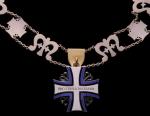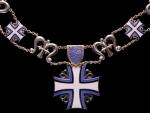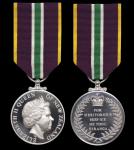-
Posts
3,944 -
Joined
-
Last visited
-
Days Won
32
Content Type
Profiles
Forums
Blogs
Gallery
Events
Store
Everything posted by Megan
-

BARBADOS: ORDER OF THE DOLPHIN?
Megan replied to Dragomir's topic in Rest of the World: Militaria & History
Still plugging away at these... have found reference to Barbados Defence Forces Meritorious Service Cross, Meritorious Service Star and Meritorious Service Medal - but only on Jean-Paul LeBlanc's old website, where he says that he has the relevant ribbons in his collection. Has anyone heard of these? -

BARBADOS: ORDER OF THE DOLPHIN?
Megan replied to Dragomir's topic in Rest of the World: Militaria & History
Don't worry, I too am happily married (for almost 30 years now!), it is merely that I follow good academic custom and acknowledge my sources on my website. -

BARBADOS: ORDER OF THE DOLPHIN?
Megan replied to Dragomir's topic in Rest of the World: Militaria & History
Thank you very much, Graeme. May I have your last name for the acknowledgements? -

BARBADOS: ORDER OF THE DOLPHIN?
Megan replied to Dragomir's topic in Rest of the World: Militaria & History
Magic... especially as I am coming up a blank trying to find any images! Graeme, is there any chance you'd permit me to use your images on my website? Full acknowledgement given, of course. -
Ethiopian Star of Victory 1941. It was issued to commemorate victory over the Italians and the restoration of sovereignty in 1941 by patriotic Ethiopian, British and Commonwealth troops who liberated the country, enabling Emperor Haile Selassie to re-enter Addis Ababa in triumph on 5 May.
-

BARBADOS: ORDER OF THE DOLPHIN?
Megan replied to Dragomir's topic in Rest of the World: Militaria & History
Excellent stuff... is there a date to this document? -

BARBADOS: ORDER OF THE DOLPHIN?
Megan replied to Dragomir's topic in Rest of the World: Militaria & History
Thank you 'mcdermp' Fattorini have replied saying that they are unable to help -

Estonia Estonia. Modern military medals.
Megan replied to pluribus's topic in Northern European & Baltic States
Thank you, Ilya. -

BARBADOS: ORDER OF THE DOLPHIN?
Megan replied to Dragomir's topic in Rest of the World: Militaria & History
With a lot of peering at that image I just put up, I think the identifications are as follows: - Top row, l-r 1. Companion of Honour of Barbados 2. Knight/Dame of St Andrews 3. Crown of Merit, Gold 4. Crown of Merit, Silver Middle row, l-r 1. Star of Gallantry 2. Defence Force Meritorious Service Star 3. Defence Force Meritorious Service Medal 4. Bravery Medal Bottom row, l-r 1. Defence Force Medal of Honour 2. Police Force Medal of Honour 3. Fire Service Medal of Honour 4. Prisons Service Medal of Honour Now on the hunt for better images that I can get permission to use... -

BARBADOS: ORDER OF THE DOLPHIN?
Megan replied to Dragomir's topic in Rest of the World: Militaria & History
Some interesting images (but unlabelled) on the Fattorini site, she says browsing it... Is this what you mean: http://www.fattorini.co.uk/pop.aspx?pi=jewellersaward5fullsize.jpg&no=9 The ribbons of some of the awards in the bottom row match Barbados police awards that I know of.. and I think that this shows a complete set of Barbados ODM. Anyway, I've just written to them to enquire. Will let you know if anything comes of it! -

BARBADOS: ORDER OF THE DOLPHIN?
Megan replied to Dragomir's topic in Rest of the World: Militaria & History
There doesn't seem to be much! A fairly dire webpage from the Barbados government has long gone but I found it in the Wayback Machine: https://web.archive.org/web/20031227095411/http://www.barbados.gov.bb/bgis/nation/honours.htm Current government page (doesn't say much more): http://www.gov.bb/bigportal/big/articles/showArticle.php?file=National_Honours_and_Decoration.xml -

Estonia Estonia. Modern military medals.
Megan replied to pluribus's topic in Northern European & Baltic States
Thanks, Noor. In the meantime I have found this as well: Kaitseliidu teenetemärkide kirjelduse ja statuudi kinnitamine Vabariigi Valitsuse 5. oktoobri 1999. a määrus nr 286 Kaitseliidu seaduse (RT I 1999, 18, 300) paragrahvi 7 lõike 4 alusel Vabariigi Valitsus määrab: 1. Kinnitada «Kaitseliidu teenetemärkide kirjeldus» 2. Kinnitada «Kaitseliidu teenetemärkide statuut» Peaminister Mart LAAR Kaitseminister Jüri LUIK Riigisekretär Aino LEPIK von WIRÉN Kinnitatud Vabariigi Valitsuse 5. oktoobri 1999. a määrusega nr 286 KAITSELIIDU TEENETEMÄRKIDE KIRJELDUS 1. VALGERIST (LISA 1) I klassi Valgeristi märk kujutab neljaharulist valget mõlemalt küljelt emailitud risti, mille esikülge ümbritseb 0,5 mm laiune kuldäär. Märgi esiküljel on kuldne mõõk, mille käepide asub risti ülemisel harul ja tera ulatub läbi risti keskme alumisele harule. Risti esiküljele, mõõga peale, on asetatud Kaitseliidu embleem. Risti tagumisel küljel on kümne millimeetrise läbimõõduga valge emailitud kuldäärtega sõõr. Sõõri sees on numbrid asetatuna üksteise alla 11. XI 1918. Risti ülemise ja külgharude pikkus on 25 mm ja alumise haru pikkus 32 mm keskmest arvestades. Risti igas harus on täisnurkne sisselõige. II ja III klassi Valgeristi märk sarnaneb I klassi Valgeristile, kuid nende ülemise ja külgharude pikkus on 20 mm ja alumise haru pikkus 27 mm keskmest arvestades. 2. TEENETEMEDAL (LISA 2) Teenetemedal kujutab külgedelt ornamentaalsete kaunistustega piiratud medaljoni, mille esikülje kujunduse põhielemendiks on ülevalt alla suunatud mõõgale medali keskmesse paigutatud Kaitseliidu embleem. Mõõka ja sellele paigutatud embleemi raamib ovaalne sõõr tekstiga PRO PATRIA. Medali kõrgus on 43 mm, mõõgatera ja käepideme laius 3,5 mm. Embleemi kõrgus on 21,5 mm ja laius 26 mm. Mõõgale paigutatud embleemi raamiva sõõri läbimõõt vertikaalsuunas on 43 mm ja horisontaalsuunas 27 mm. Sõõri külgedelt piiravate ornamentaalsete kaunistuste kõrgus on 29 mm ja suurim laius 2,5 mm. Medali tagakülg on sile ja sellele graveeritakse medali number ning andmise aeg. Teenetemedali kolme põhiklassi medalid on azuursed, eriklassi teenetemedalil on embleemi taust ning vapilõvid kaetud vastavalt oranzi ja sinise emailiga. Ülevalt alla suunatud mõõk ja embleem on valmistatud hõbedast ning oksüdeeritud. Ornamentaalsete kaunistustega ovaal on III klassil pronksivärvi, II klassil hõbedane, I klassil ja eriklassil kuldne. Deviis PRO PATRIA on kõikide klasside medalitel oksüdeeritud tumedaks. Kaitseminister Jüri LUIK Kinnitatud Vabariigi Valitsuse 5. oktoobri 1999. a määrusega nr 286 KAITSELIIDU TEENETEMÄRKIDE STATUUT I. ÜLDSÄTTED 1. Kaitseliidu teenetemärgid on: 1) 30. novembril 1997. a asutatud Kaitseliidu teenetemedal; 2) 19. juunil 1929. a asutatud Kaitseliidu Valgerist. II. TEENETEMÄRKIDE KLASSID 2. Kaitseliidu Valgerist jaguneb kolmeks klassiks. Klasside järjekord alates kõrgemast on I, II ja III klass. 3. Valgerist antakse: 1) kaitseliitlasele eriliste teenete eest või eriti eeskujuliku või pikaajalise teenistuse eest Kaitseliidus; 2) teistele Eesti ning välisriikide kodanikele Kaitseliidule osutatud eriliste teenete eest. 4. Kaitseliidu teenetemedal jaguneb kolmeks põhiklassiks ja eriklassiks. 5. Teenetemedali klassid on: III klass Kaitseliidu pronksist teenetemedal II klass Kaitseliidu hõbedane teenetemedal I klass Kaitseliidu kuldne teenetemedal Eriklass Kaitseliidule osutatud väljapaistvate teenete eest antav medal 6. Teenetemedal antakse: III klass kaitseliitlastele väljapaistva teenistuse eest Kaitseliidus, kui teenistust on 4 9 aastat; II klass kaitseliitlastele väljapaistva teenistuse eest Kaitseliidus, kui teenistust on 10 15 aastat; I klass kaitseliitlastele väljapaistva teenistuse eest Kaitseliidus, kui teenistust on 16 ja enam aastat; Eriklass kaitseliitlastele ühekordsete väljapaistvate teenete eest Kaitseliidu ees või teistele Eesti ning välisriikide kodanikele Kaitseliidule osutatud väljapaistvate teenete eest. III. TEENETEMÄRKIDE ANDMINE 7. Valgeristi antakse klasside järjekorras. Kaitseliidu keskjuhatus võib otsustada Valgeristi andmise väljaspool klasside järjekorda. 8. Teenetemärkide andmise otsustab Kaitseliidu keskjuhatus. 9. Kiireloomulistel juhtudel, kui keskjuhatust pole võimalik kokku kutsuda, võib teenetemedali eriklassi anda Kaitseliidu ülem, teavitades sellest keskjuhatust. 10. Teenetemärgi kätteandmine toimub pidulikult vabariigi aastapäeval, Kaitseliidu aastapäeval, maleva, malevkonna või kompanii aastapäeval, iseseisvuspäeval ja teistel tähtpäevadel. 11. Valgeristi andmist tõendab vastav tunnistus, millel on Kaitseliidu pitser sissepressitud kujul. Tunnistusele kirjutavad alla Kaitseliidu ülem ning Kaitseliidu Peastaabi ülem. 12. Teenetemedali andmist tõendab vastav tunnistus, millele kantakse medali number. Tunnistusele kirjutavad alla Kaitseliidu ülem ja keskjuhatuse esindaja. IV. TEENETEMÄRKIDE KANDMINE 13. Valgeristi kandmine I klassi Valgeristi kantakse lindiga kaelas. Lindi laius on 40 mm, mis jaguneb: 2 mm rukkilillesinine kant, 0,5 mm valge, 3,5 mm oranz, 0,5 mm valge, 13 mm rukkilillesinine, 1 mm valge, 13 mm rukkilillesinine, 0,5 mm valge, 3,5 mm oranz, 0,5 mm valge ja 2 mm rukkilillesinine kant. II klassi Valgeristi kantakse lindiga vasakul rinnal. Lindi laius on 34 mm, mis jaguneb: 1,5 mm laiune rukkilillesinine kant, 0,5 mm valge, 4 mm oranz, 0,5 mm valge, 21 mm rukkilillesinine, 0,5 mm valge, 4 mm oranz, 0,5 mm valge ja 1,5 mm rukkilillesinine kant. Lindil on 20 mm läbimõõduga oranzi värvi siniste triipudega rosettmärk. III klassi Valgeristi kantakse ilma rosettmärgita vasakul rinnal, vasakul pool II klassi Valgeristi. Lindi laius on 34 mm, mis jaguneb: 1,5 mm laiune rukkilillesinine kant, 0,5 mm valge, 4 mm oranz, 0,5 mm valge, 21 mm rukkilillesinine, 0,5 mm valge, 4 mm oranz, 0,5 mm valge ja 1,5 mm rukkilillesinine kant. Valgeristi märkide asemel võib kanda nende linte ja miniatuurmärke: I klassi kavaler kannab esimese klassi Valgeristi linti; II klassi kavaler kannab II klassi Valgeristi linti koos oranzi rosettmärgiga; III klassi kavaler kannab III klassi Valgeristi linti ilma rosettmärgita. Isik, kellele on antud Valgeristi eri klassi märgid, kannab ainult kõrgeima klassi märki. Miniatuurmärke kantakse kuue vasakul revääril. Valgeristi linti ja miniatuurmärki võib kanda igal ajal. 14. Teenetemedali kandmine Teenetemedalit kantakse lindiga rinnas vasakul pool Valgeristi järel, st vastavalt eriklass, I klass, II klass ja III klass. Lindi laius on 34 mm, mis jaguneb: III klassil 12 mm rukkilillesinine, 1 mm valge, 2 mm oranz, 1 mm valge, 2 mm oranz, 1 mm valge, 2 mm oranz, 1 mm valge ja 12 mm rukkilillesinine; II klassil 12 mm rukkilillesinine, 1 mm valge, 3,5 mm oranz, 1 mm valge, 3,5 mm oranz, 1 mm valge ja 12 mm rukkilillesinine; I klassil 12 mm rukkilillesinine, 1 mm valge, 8 mm oranz, 1 mm valge ja 12 mm rukkilillesinine; eriklassil I klassi lint, millele on asetatud 22 mm läbimõõduga rosett, mis on valmistatud III klassi lindist. Kaitseliidu teenetemärgid ei ole riiklikud autasud, neid kantakse Eesti riiklike teenetemärkide järel. Teenetemedali asemel võib kanda selle lindilõiget või miniatuurmärki kuue vasakul revääril sellises järjestuses, kus kõrgem klass on paremal. Kaitseminister Jüri LUIK Lisa 1 «Kaitseliidu teenetemärkide kirjelduse» juurde Kaitseliidu Valgerist I klass II klass III klass Lisa 2 «Kaitseliidu teenetemärkide kirjelduse» juurde Kaitseliidu teenetemedalid Eriklass Kaitseliidu eriteenete medal I klass Kaitseliidu kuldne medal II klass Kaitseliidu hõbedane medal III klass Kaitseliidu pronksist medal -

Estonia Estonia. Modern military medals.
Megan replied to pluribus's topic in Northern European & Baltic States
PS If Pluribus is around, could he please let me know (by PM if preferred) what his name is for the acknowlegements page! -

Estonia Estonia. Modern military medals.
Megan replied to pluribus's topic in Northern European & Baltic States
I have started poking around in modern Estonian medals, and adding what information I can find to my site. Please do bob over and proffer any suggestions & comments. I have found a document in Estonian (which I don't know a word of!) which I think is quite recent - February 2013? - and would be grateful if anyone who can read it (better than Google Translate, their version is virtually unintelligible!) could give me a hand with it... -
Congratulations to the winners and indeed all entrants who made judging so, so difficult (if pleasurable!).
-
I think it may be a society order - the French are fond of such things - for the Ligue Républicaine du Bien Public (Universal League of Public Welfare) which has quite a long history of working for the public good and has NGO status with the UN. I've seen a breast badge with the same design as that mounted on the star, suspended from a red ribbon with a central narrow black stripe, attributed to this League.
-
Still plodding on adding Nigerian medals to my website. Antonio mentions a 1963 Independence Medal (as well as the 1960 one, which I added to the site today): does anyone know anything about that? Nigeria gained independence from Britain on 1 October 1960, so what is the 1963 one all about?
-
If it were green rather than blue at the edges, the Armed Resistance Medal 1940-1945 would be a possible. Are you certain of the blue?
-

Serbia Medals from the Republika Srpska
Megan replied to Drugo's topic in Southern European & Balkan States
Arrgh - another area I need to get on my website! Thanks for all the information, now to scamper off and find images I can use... -
No, Peter - that's the Nigeria Police Star (which is its official name although it looks like a cross!). I am after more information on the Prison Service gallantry award. I've posted the official description which is at complete variance with the 'Prison Service Cross' Emmanuel has!
-
This is quite unlike the description given in the Honours (Prison Service) Warrant of 14 April 1972. This describes a Maltese Cross of silver metal with the outer edges joined by a coiled ring, having, on the obverse, in the centre, a shield similar to that forming part of the arms of the Federal Republic, the shield being surrounded by a laurel wreath and the uppermost arm of the cross having on it a representation of an eagle, and on the reverse, the words "FOR GALLANTRY" in the centre and "THE NIGERIA PRISON SERVICE" at the upper arm of the cross. The ribbon is blue with a green-edged red central stripe bearing a narrow white stripe.
-

Bundesrepublik Flood Service Medal 2002
Megan replied to TacHel's topic in Germany: Post 1945: Bundesrepublik & DDR
Nice site - who runs it? The 'about us' page is signed "The Author" which isn't very informative! -





